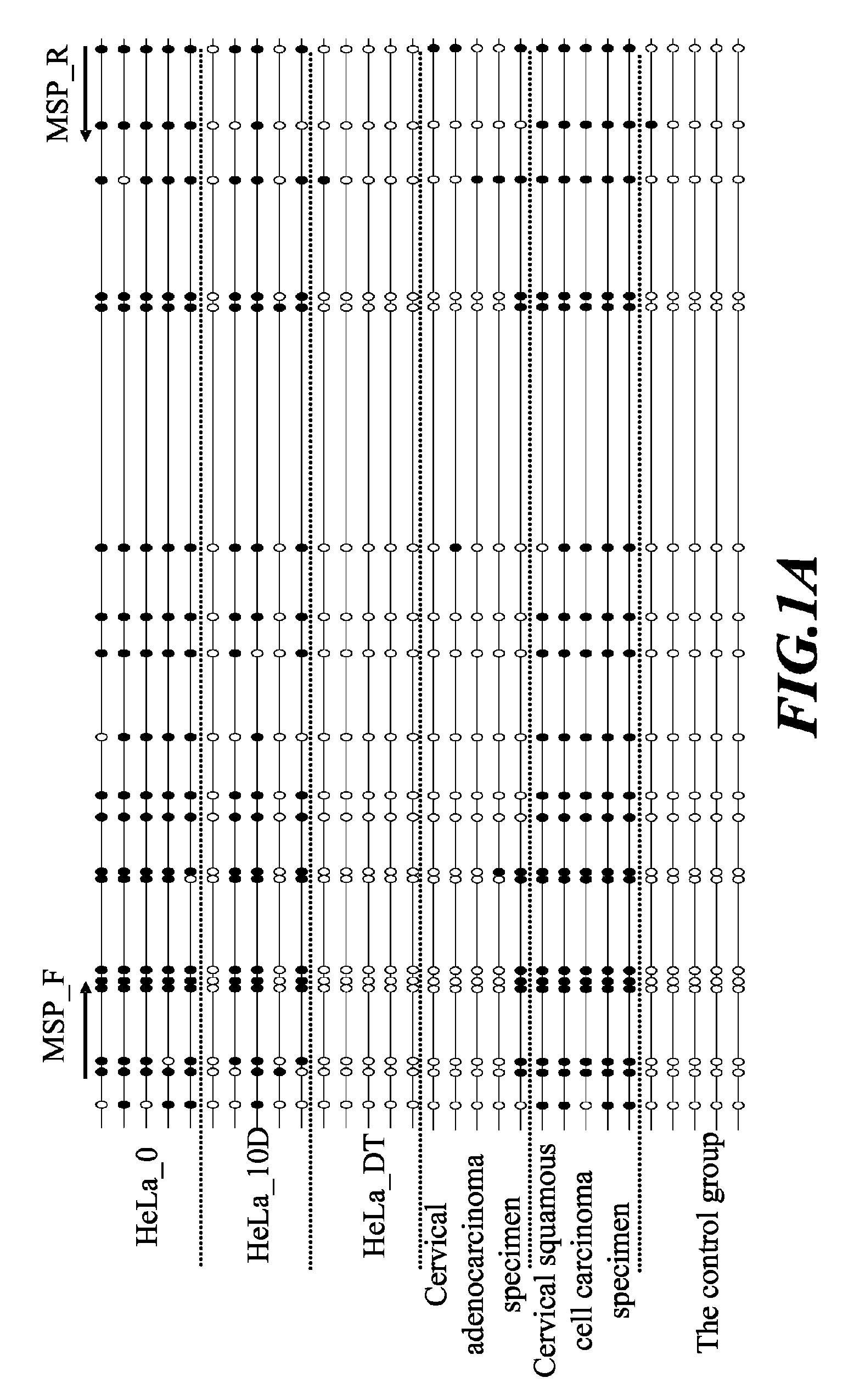Cancer screening method
a screening method and cancer technology, applied in the field of cancer screening biomarkers and cancer screening methods, can solve the problems of high false negative rate of pap smear, high manpower cost, and many undesired properties of pap smear testing, and achieve the effect of more accurate cervical cancer screening effects
- Summary
- Abstract
- Description
- Claims
- Application Information
AI Technical Summary
Benefits of technology
Problems solved by technology
Method used
Image
Examples
example 1
Materials and Methods
1. Materials
[0043]Test materials comprises a series of full cervical lesion specimens, including: squamous cell carcinoma (SCC, n=20), adenocarcinoma (AC, n=20), and normal cervical specimen (n=10). All of these cervical specimen, ovarian specimen, and colon cancer specimen were obtained from Tri-service General Hospital, Taipei, ROC. Each specimen was subjected to genomic DNA extraction by means of QIAamp DNA Kit (QIAGEN), and was used in the comparison and analysis of DNA methylation condition within genome-wide DNA methylation. Prior to the analysis, the quality of genomic DNA was checked by Bioanalyzer (Agilent). In this example, 10 μg of fragmented DNA was subjected to MeDIP (Methyl DNA IP) assay.
2. DNA Methylation Analysis by MeDIP and CpG Island-Plus-Promoter Arrays
[0044]Genomic DNA was fragmented to the size ranging from 300 to 1,000 bp by Bioruptor™ UCS-200 (Diagenode). It was immunoprecipitated overnight at 4° C. with 30 μl of polyclonal Anti-5′-methyl...
example 2
Screening of Methylated Target Gene in Cervical Cancer
[0052]After screened by CpG island-Plus-Promoter arrays, four target genes that might have been highly methylated in the cervical cancer cell were screened, namely, DBC1 (SEQ ID No: 1), PDE8B (SEQ ID No: 2), PTPRR (SEQ ID No: 3) and ZNF582 (SEQ ID No: 4), respectively. Their detailed information was shown in Table 3. It could be seen from Table 3 that, among these four genes, except DBC1 that was known to be associated with bladder cancer, little study up to date had revealed the relation of those genes to cervical cancer.
[0053]
TABLE 3Characteristics of methylated genes in cervical cancer thatwere identified using a CpG island-Plus-Promoter microarray.ChromosomalGeneUniGenelocationFull nameSEQ ID NoDBC1NM_0146189q32-q33deleted in bladder cancer 1SEQ ID No: 1PDE8BNM_0037195q14.1phosphodiesterase 8BSEQ ID No: 2PTPRRNM_00284912q15protein tyrosine phosphatase,SEQ ID No: 3receptor type, RZNF582NM_14469019q13.43zinc finger protein 582S...
example 3
The Analysis of Methylation State of Target Gene in Cervical Lesion Specimen by Bisulfite Sequencing (BS)
The Target Gene: PTPRR
[0054]Test Specimen Groups:[0055]1. HeLa—0: HeLa cervical cancer cell line;[0056]2. HeLa—10D: HeLa cervical cancer cell line (HeLa—0) treated with 10 μM DNA methyltransferase inhibitor 5′-aza-2′-deoxycytidine (AZC);[0057]3. HeLa_DT: HeLa cervical cancer cell line (HeLa—0) treated with both of 10 μM DNA methyltransferase inhibitor 5′-aza-2′-deoxycytidine (AZC) and 0.33 μM TSA (Sigma Chemical Co., St. Louis, Mo.);[0058]4. AC: Cervical adenocarcinoma specimen;[0059]5. SCC: Cervical squamous cell carcinoma specimen; and[0060]6. Control group (normal): normal cervical blood DNA as the control group without methylation.
[0061]Each of those test specimens described above was subjected to bisulfite modification, and then bisulfite sequencing (BS) to analyze whether the target gene (PTPRR) in each test specimen has been hypermethylated or not. The results are shown in...
PUM
| Property | Measurement | Unit |
|---|---|---|
| volume | aaaaa | aaaaa |
| volume | aaaaa | aaaaa |
| volume | aaaaa | aaaaa |
Abstract
Description
Claims
Application Information
 Login to View More
Login to View More - R&D
- Intellectual Property
- Life Sciences
- Materials
- Tech Scout
- Unparalleled Data Quality
- Higher Quality Content
- 60% Fewer Hallucinations
Browse by: Latest US Patents, China's latest patents, Technical Efficacy Thesaurus, Application Domain, Technology Topic, Popular Technical Reports.
© 2025 PatSnap. All rights reserved.Legal|Privacy policy|Modern Slavery Act Transparency Statement|Sitemap|About US| Contact US: help@patsnap.com



